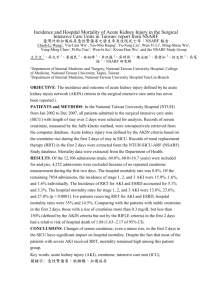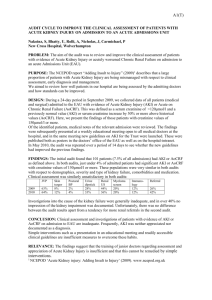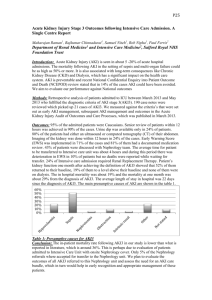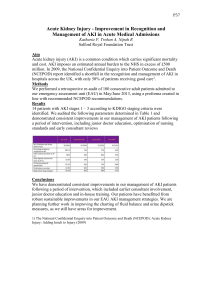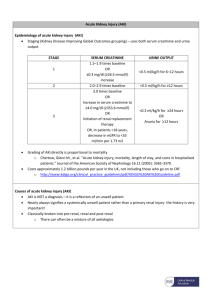Full paper
advertisement
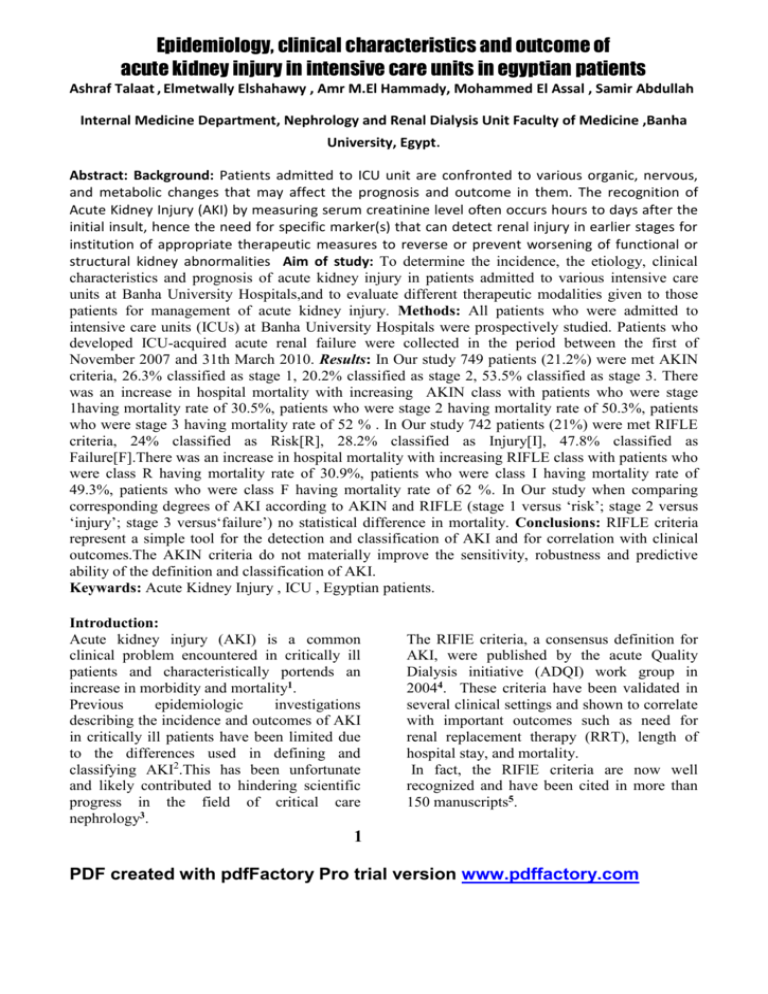
Epidemiology, clinical characteristics and outcome of acute kidney injury in intensive care units in egyptian patients Ashraf Talaat , Elmetwally Elshahawy , Amr M.El Hammady, Mohammed El Assal , Samir Abdullah Internal Medicine Department, Nephrology and Renal Dialysis Unit Faculty of Medicine ,Banha University, Egypt. Abstract: Background: Patients admitted to ICU unit are confronted to various organic, nervous, and metabolic changes that may affect the prognosis and outcome in them. The recognition of Acute Kidney Injury (AKI) by measuring serum creatinine level often occurs hours to days after the initial insult, hence the need for specific marker(s) that can detect renal injury in earlier stages for institution of appropriate therapeutic measures to reverse or prevent worsening of functional or structural kidney abnormalities Aim of study: To determine the incidence, the etiology, clinical characteristics and prognosis of acute kidney injury in patients admitted to various intensive care units at Banha University Hospitals,and to evaluate different therapeutic modalities given to those patients for management of acute kidney injury. Methods: All patients who were admitted to intensive care units (ICUs) at Banha University Hospitals were prospectively studied. Patients who developed ICU-acquired acute renal failure were collected in the period between the first of November 2007 and 31th March 2010. Results: In Our study 749 patients (21.2%) were met AKIN criteria, 26.3% classified as stage 1, 20.2% classified as stage 2, 53.5% classified as stage 3. There was an increase in hospital mortality with increasing AKIN class with patients who were stage 1having mortality rate of 30.5%, patients who were stage 2 having mortality rate of 50.3%, patients who were stage 3 having mortality rate of 52 % . In Our study 742 patients (21%) were met RIFLE criteria, 24% classified as Risk[R], 28.2% classified as Injury[I], 47.8% classified as Failure[F].There was an increase in hospital mortality with increasing RIFLE class with patients who were class R having mortality rate of 30.9%, patients who were class I having mortality rate of 49.3%, patients who were class F having mortality rate of 62 %. In Our study when comparing corresponding degrees of AKI according to AKIN and RIFLE (stage 1 versus ‘risk’; stage 2 versus ‘injury’; stage 3 versus‘failure’) no statistical difference in mortality. Conclusions: RIFLE criteria represent a simple tool for the detection and classification of AKI and for correlation with clinical outcomes.The AKIN criteria do not materially improve the sensitivity, robustness and predictive ability of the definition and classification of AKI. Keywards: Acute Kidney Injury , ICU , Egyptian patients. Introduction: Acute kidney injury (AKI) is a common clinical problem encountered in critically ill patients and characteristically portends an increase in morbidity and mortality1. Previous epidemiologic investigations describing the incidence and outcomes of AKI in critically ill patients have been limited due to the differences used in defining and classifying AKI2.This has been unfortunate and likely contributed to hindering scientific progress in the field of critical care nephrology3. The RIFlE criteria, a consensus definition for AKI, were published by the acute Quality Dialysis initiative (ADQI) work group in 20044. These criteria have been validated in several clinical settings and shown to correlate with important outcomes such as need for renal replacement therapy (RRT), length of hospital stay, and mortality. In fact, the RIFlE criteria are now well recognized and have been cited in more than 150 manuscripts5. 1 PDF created with pdfFactory Pro trial version www.pdffactory.com Table (1): Risk, Injury, Failure, Loss of function and End stage kidney disease (RIFLE) staging system.(4): RIFLE Serum creatinine criteria Urine output criteria Risk SCr ≥ 1.5X baseline < 0.5 mL/kg/h > 6 h Injury SCr ≥ 2.0X baseline < 0.5 mL/kg/h > 12 h Failure SCr ≥ 3.0X baseline or serum creatinine ≥ 4mg/dL with an absolute increase of > 0.5mg/dL < 0.3 mL/kg/h > 24 h or anuria > 12 h Loss Complete loss of kidney function > 4 wks ESK End-stage kidney disease> 3 months More recently, the Acute Kidney Injury Network (AKIN) group, an international collaboration of nephrologists and intensivists, have proposed refinements to the RIFLE criteria6. In particular, the AKIN group sought to increase the sensitivity of the RIFLE criteria by recommending that a smaller change in serum creatinine (≥26.2 μmol/L) can be used as a threshold to define the presence of AKI and identify patients with Stage 1 AKI (analogous to RIFLE-Risk). Second, a time constraint of 48 h for the diagnosis of AKI was proposed. Finally, any patients receiving renal replacement therapy (RRT) were now to be classified as Stage 3 AKI (RIFLE-Failure). It is currently unknown whether discernible advantages exist with one approach to definition and classification versus the other7. Table (2): The Acute Kidney Injury Network (AKIN) staging system. AKIN Serum creatinine criteria Urine output criteria Stage 1 SCr ≥ 1.5X baseline or increase in SCr ≥ 0.3 mg/dL from baseline SCr ≥ 2.0X baseline < 0.5 mL/kg/h > 6 h Stage 2 Stage 3 SCr ≥ 3.0X baseline or serum creatinine ≥ 4.0 mg/dl (≥ 354 μmol/l) with an acute increase of at least 0.5 mg/dl (44 μmol/l) or initiated on RRT (irrespective of stage at time of initiation) < 0.5 mL/kg/h > 12 h < 0.3 mL/kg/h > 24 h or anuria > 12 h SCr: serum creatinine, GFR: glomerular filtration rate, AKIN: Acute Kidney Injur Network, RRT: renal replacement therapy (7). Methods: For each patient with ICU acquired acute kidney Patients were categorized on serum creatinine or injury, Details and variables such as age, gender, urine output, or both; the criteria that led to the race, body weight, cardiovascular disease, need worst classification were used. At least two serum for mechanical ventilation, vasopressors, serum creatinine values within 48 hours were considered creatinine, urine output, RRT, and outcome were in order to define AKI. Statistical analysis of the collected. AKI was defined and classified by data was done. means of AKIN and RIFLE criteria (Table 1&2) 2 PDF created with pdfFactory Pro trial version www.pdffactory.com Results: Base line characteristics: The present study comprised 749 patients with ICU-acquired acute kidney injury with prevalence rate 21.2% (total admission of 3350 patients, admitted to different ICUs during the study). The age of the patients ranged from 17 years to 86 years (mean 50.6 ± 16.2). This study included 537 male patients 71.7% and 212 female patients 28.3%. ICU acquired-AKI were divided into 6 groups: Group 1: patients with ICU acquired AKI due to ischemic ATN (iATN): Two hundred sixty four (264) patients (35.3%). Group 2: patients with ICU acquired AKI due to prerenal causes: one hundred ninety eight (198) patients (26.4%). Group 3: patients with ICU acquired AKI due to toxic ATN(T.ATN): sixty four (64) patients (8.5%). Group 4: patients with ICU acquired AKI due to sepsis induced AKI: one hundred four (104) patients (13.9%). Group 5: patients with ICU acquired AKI due to Hepatorenal syndrome (HRS):eighty one (81) patients (10.8%). Group 6: patients with ICU acquired AKI due to other causes: This group included thirty eight (38) patients (5.1%). o Microangiopathies (HUS, TTP, HELLP, DIC) eighteen (18) patients 47.4%. o Pigment nephropathy e.g. Rhabdomyolysis nine (9) patients 37.7%. o Obstructive uropathy (3) patients 7.9%. o Unknown cause eight (8) patients 21% Statistical methodology: Analysis of data was done by IBM computer using statistical program for social science (SPSS) as follows: • Description of quantitative variables as mean, SD and range. • Description of qualitative variables as number and percentage. • Chi- square test was used to compare qualitative variables. • Unpaired t-test was used to compare two independent groups as regard a quantitative variable. • One way (ANOVA test) was used to compare more than two groups as regard quantitative variable. • Correlation co-efficient rank test was used to rank different variables against each other in linear correlation which was positive or negative. • Receiver operator characteristic curve (ROC) was used to find out the overall predictivity of certain variable. And to find out the best cut of value with detection of sensitivity, specificity at this cut off value. • Sensitivity = ability of the test to detect positive results = true +ve / true +ve + false –ve. • Specificity = ability of the test to exclude negative results = true –ve/true-ve + false +ve. • Positive predictive value (PPV) = % of true +ve to all positive results = true+ve / true+ve + false +ve. • Negative predictive value (NPV) = % of true – ve to all negative results = true–ve / true –ve + false +ve. • P value (>0.05) is insignificant, P value (<0.05) is significant, P value (<0.01) is highly significant. 3 PDF created with pdfFactory Pro trial version www.pdffactory.com Table (3): Comparison between Baseline clinical and biochemical characteristics of different groups of ICU acquired AKI. Characteristics (n=64) Toxic group Septic group (n=104) Hepato renal group (n=81) Pre renal group (n=198) Ischemic ATN Group (n= 264) P Age 62.2 ± 12.4 60.3±10.5 61.2 ± 11.4 55.2 ± 13.4 57.2 ± 10.4 Sex 76.6 : 23.4 77.9: 22.1 74.1 : 25.9 74.2 : 25.8 75.8 : 24.2 Mechanical ventilation Vasoactive drugs 54.2 : 45.8 57.3: 42.7 17.8 : 82.2 17.8: 82.2 17.8: 82.2 55.2 : 44.8 >0.05 >0.05 <0.05 35.8: 64.2 68.2 : 31.8 31.8: 68.2 21.8: 78.2 33.8: 66.2 HR 90.3 ± 11.5 96.3±12.5 11.37+8.2 ± 83.3 ± 11.9 83.3 ± 12.5 RR 22.5 ± 3.9 21.3±4.2 23.6 ±3.3 23.8 ± 3.7 21.3 ± 4.2 SBP 128.1 ± 21.5 105.3±20.3 111.2 ± 21.6 113.2 ± 21.9 120.3 ± 20.3 MAP 76.1 ± 8.5 57.1±9.3 67.1 ± 8.3 68.1 ± 8.5 78.1 ± 9.3 CVP 9.3 ± 3.9 7.3±4.9 8.2 ± 3.3 5.5 ± 3.4 8.3 ± 3.9 WBCS 12.9 ± 3.4 17.3±3.8 10.5 ± 3.1 11.7 ± 3.3 13.3 ± 3.8 Platlet 127.3 ± 23.1 88.3±25.7 127.9 ± 23.4 127.3 ± 23.1 126.3 ± 25..1 Billirubin 1.25 ± 0.1 1.3±0.2 6.9 ± 1.5 1.23 ± 0.1 1.39 ± 0.6 S. Na 133.4 ± 12.9 138.4±12.9 134.4 ± 13.4 135.4 ± 13.9 135.4 ± 11.9 S. K 4.27 ± 0.88 4.7±1.2 4.25 ± 0.8 4.23 ± 0.89 4.3 ± 1.1 PH 7.33 ± 0.15 7.32±0.1 7.29 ± 0.1 7.3 ± 0.18 7.35 ± 0.2 Bicarbonate 17.9 ± 4.3 14.6±5.4 17.67 ± 3.97 17.7 ± 4.1 18.6 ± 5.9 Po2 92.2 ± 13.1 88.1 ±11.1 90.7 ± 10.9 48 (75%) 29 (27.9%) 16 (25%) 25 (24%) Failed organ other than ARF 0 1 2 3 and More 81 (100%) 95.1 ± 12.1 94.2 ± 15.1 170 (85.9%) 133 (50.4%) 28 (14.1%) 75 (28.4%) 12 (3.5%) 38 (14.4%) 38 (36.5%) 18 (6.8%)- RIFLE criteria and AKIN criteria According to AKIN criteria acute kidney injury occurred in 749 patients (21.2%), with stage1 <0.05 <0.05 >0.05 <0.05 <0.05 >0.05 <0.05 <0.05 <0.05 >0.05 >0.05 >0.05 >0.05 >0.05 <0.05 <0.05 <0.05 <0.05 in197 patients (26.3%), stage 2 in 151 patients (20.2%) and stage 3 in 401 patients (53.5 %). Table (4): ICU acquired AKI patients stratified by acute kidney network criteria. Stages No. and percent of the patient Stage 1 197 (26.3%) Stage 2 151 (20.2% Stage 3 401 (53.5%) Total 749 (100%) According toRIFLE criteria acute kidney injury occurred in 742 patients (21%), with category Risk in 178 patients (24%), Injury in 209 patients (28.2%) and failure in 355 patients (47.8%). 4 PDF created with pdfFactory Pro trial version www.pdffactory.com Table (5): ICU acquired AKI patients stratified by risk, injury, failure, loss and end stage renal disease (RIFLE) criteria. Stages No. and percent of the patient Risk 178 (24%) Injury 209 (28.2%) Failure 355 (47.8%) Total 742 (100%) Outcome: Mortality rates were 30.5%, 50.3%, and 52% in AKIN stage 1, stage 2, and stage 3 groups, respectively. There is progressive increase in mortality rate across different classes of AKIN staging system. There are significant statistical differences, P value was in all p value < 0.001. Mortality rate in class R was 30.9%, in class I was 49.3%, while in class F was 62 %, there is progressive increase in mortality rate across different classes of RIFLE staging system. There are significant statistical differences, P value was in all p values < 0.001. Table (6): Comparison between mortality in different stages in RIFLE & AKIN. Stage of RIFLE versus stage of AKIN Mortality P value Risk vs. stage 1 31.1% v 30.6% > 0.05 Injury vs. stage 2 49.3% v 50.3% > 0.05 Failure vs. stage 3 59.2% v 60.6% > 0.05 Discussion: We conducted a prospective study to analyze the clinical Characteristics of the ICU acquired AKI in light of the AKIN and RIFLE classifications, and to evaluate the capacity of this system in predicting in hospital mortality of patients with AKI. In our study the prevalence of ICU-acquired acute renal failure was found to be 21.2% and this is consistent with that reported by Santos et al.8 who found the incidence rate to be 22.6%. Also, Clermont et al.9 & Chawla et al.10 found the incidence of ARF in ICU patients to be 17% & 18% respectively. In our study, ischemic acute tubular necrosis represented the most common etiological diagnosis (35.3%). Other authors agree with these results. Santos et al.8 reported that ischemic ATN was the most common cause of ARF in ICU with an incidence rate of (48%) & (51%) respectively. The overall mortality rate was 51.7% in our study similar to that (51.9%) found by11. Also Hoste et al.12 found a mortality rate of 56.7%. Ricci and Ronco13 suggested that a 50-60% crude mortality associated with ARF represents an acceptable level of performance to the health care system because as therapeutic capacity improves, the health care system will progressively admit and 5 PDF created with pdfFactory Pro trial version www.pdffactory.com treat sicker and sicker patients with ARF. Among different causes of ICU-acquired ARF, hepatorenal syndrome showed the highest mortality rate (100%). These results were consistent with that of Cosentino et al.14 and Bunn et al.15 who reported (100% & > 90%) mortality respectively. In Our study 742 patients were met RIFLE criteria, 24% classified as Risk, 28.2% classified as Injury, 47.8% classified as failure, this high percentage of failure class agrees with Hoste and colleagues who evaluated RIFLE as an epidemiological and predictive tool in 5,383 critically ill patients. They found that AKI occurred in a staggering 67% of patients, with 12% achieving class of R, 27% class I, and 28% class F16. There was an increase in hospital mortality with increasing RIFLE class with patients who were class R having mortality rate of 30.9% , patients who were class I having mortality rate of 49.3% , patients who were class F having mortality rate of 62 % ,this progressive increase across different classes of RIFLE staging system agrees with Ricci et al.13 who analyzed data for more than 71,000 patients from published reports from August 2004 to June 2007 that have utilized RIFLE criteria and found that with Mortality was 18.9%, 36.1%, and 46.5% in RIFLE class R, class I, and class F groups, respectively17. In Our study 749 patients were met AKIN criteria , 26.3% classified as stage 1, 20.2% classified as stage 2, 53.6% classified as stage 3, in our study increasing AKIN stages correlated with increasing mortality, 30.5%, 50.3%, and 52% in AKIN stage 1, stage 2, and stage 3 groups, respectively, this agrees with Lopes et al.,18 who found that mortality rate was in stage 1 (34.6%), in stage 2 (45%), and in stage 3(64.1%). In our study, number of patients was 742 according to RIFLE criteria and 749 according to AKIN criteria with a small difference only 0.9%, this agrees with Bagshaw et al.19, but lower by 2.2% found by Lopes et al. 18. When comparing corresponding degrees of AKI according to AKIN and RIFLE (stage 1versus ‘risk’; stage 2versus ‘injury’; stage 3 versus ‘failure’) no statistical difference in mortality (P value >0.05). Similar results were found by Ando et al.20 and Bagshaw et al.19 Conclusion: The recognition of AKI, using serum creatinine ,often occurs hours to days after the initial insult hence the need for a recent specific marker, that can detect a significant renal injury immediately. RIFLE criteria represent a simple tool for the detection and classification of AKI and for correlation with clinical outcomes. The AKIN criteria do not materially improve the sensitivity, robustness and predictive ability of the definition and classification of AKI. References: 1)- Uchino S, Kellum J, Bellomj R, et al. (2005): Acute Renal Failure in critically ill Patients, A multinational, multi-center study. JAMA; 294: 813-818. 2)- Bagshaw SM, Laupland KB, Doig CJ, et al. (2005): Prognosis for long-term survival and renal recovery in critically ill patients with severe acute renal failure: a population-based study. Crit Care; 9: R700-R709. 3)- Kellum JA, Levin N, Bouman C, et al. (2002): Developing a consensus classification system for acute renal failure. Curr Opin Crit Care; 8: 509–514 4)- Bellomo R, Naka T and Baldwin I (2004): Intravenous fluids and acid-base balance. Contrib Nephrol; 144: 105–18. 5)- Bellomo R, Kellum JA and Ronco C (2007): Defining and classifying acute renal failure: from advocacy to consensus and validation of the RiFLE criteria. Intensive Care Med. 33, 409-413. 6)- Mehta RL, Kellum JA, Shah SV et al. (2007): Acute kidney injury network: report of an initiative to improve outcomes in acute kidney injury. Crit Care; 11: R31 7)- Seerapani Gopaluni, Simon Lines, Andrew J.P. Lewington (2010): Acute kidney injury in the critically ill patient: Curren Anaesthesia & Critical Care 21: 60–64. 8)- Santos WJ, Zanetta DM, Pires AC, et al. (2006): Patients with ischemic, mixed and nephrotoxic acute tubular necrosis in intensive care unit crit care (10) 2: 68-76. 9)- Clermont G, Acker C, Angus DC, et al. (2002): Renal failure in the ICU: comparison of the impact of acute renal failure and end stage renal disease on ICU outcomes. Kidney Int.; 62: 986- 996. 10)- Chawla L, Abell L, Mazhari R et al. (2005): Identifying critically ill patients at high risk for developing acute renal failure. Kid. Int., vol 68, 2274-2280. 6 PDF created with pdfFactory Pro trial version www.pdffactory.com 11)- Mehta RL, Pascual MT, Gruta CG, et al. (2002): Refining Predictive models in critically ill patients with acute renal failure. J Am Soc Nephrol; 13: 1350- 1357. 12)- Hoste EA, Lameire NH,Vanholder RC, et al. (2003): Acute renal failure in patients with sepsis in a surgical ICU: predictive factors, incidence, comorbidity, and outcome. J Am Soc Nephrol; 14: 1022–30. 13)- Ricci Z and Ronco C, et al. (2007): Kidney diseases beyond Nephrology – intensive care. Nephrol Dialysis transplant. 10. 832-835. 14)- Cosentino F, Chaff C and Piedmonte M (1994): Risk factors influencing survival in ICU acute renal failure. Nephrol Dial Transplant 1994; 9 (4): 179-182. 15)- Bunn AD, Symons JM and stock A (2006): Hepatorenal syndrome. E medicine. 16)- Hoste EA, Clermont G, Kersten A, et al. (2006): RIFLE criteria for acute kidney injury are associated with hospital mortality in critically ill patients: A cohort analysis. Crit Care 10: R73. 17)- Ricci, Z., D. Cruz, and C. Ronco, (2008): The RIFLE criteria and mortality in acute kidney injury: a systematic review. Kidney Int, 73(5): p. 538–46. 18)-Lopes J A, Jorge S, Resina C:Acute Kidney injury in patients with sepsis: a contemporary analysis .International Journal of Infectious Diseases(2009) 13,176-181. 19)- Bagshaw SM, George C and Bellomo R (2008): A comparison of the RIFLE and AKIN criteria for acute kidney injury in critically ill patients, Nephrol Dial Transplant; 23: 1569–1574 20)- Ando M, J Mori, K Ohashi, et al. (2010): A comparative assessment of the RIFLE, AKIN and conventional criteria for acute kidney injury after hematopoietic SCT Bone Marrow Transplantation 45, 14271434doi:10.1038/bmt.2 7 PDF created with pdfFactory Pro trial version www.pdffactory.com 8 PDF created with pdfFactory Pro trial version www.pdffactory.com
